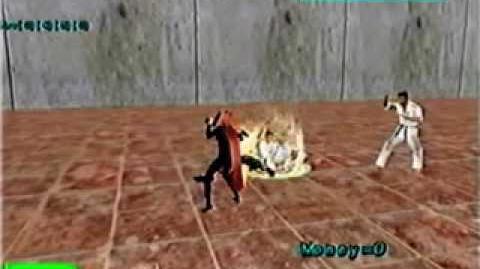- This article is about the first game in the series. For the protagonist of Bayonetta, see Bayonetta (character).
Bayonetta (ベヨネッタ) is an action game developed by PlatinumGames and published by Sega for Xbox 360 and PlayStation 3. Directed by Hideki Kamiya, creator of the Devil May Cry series, Viewtiful Joe, and Okami, it was released in Japan in October 2009, and January 2010 in North America and Europe. Set in a fictional city in Europe, Vigrid, the game centers on its title character, Bayonetta, a witch who can wield four handguns—among other weapons—and perform magical attacks to defeat various enemies. The game has five difficulty settings; its two easiest ones contain a game mode playable with only one button, similar to a mode Kamiya used in Devil May Cry. Its characters were designed with modern style and fashion in mind, while its music is largely upbeat and feminine.
Bayonetta began development around January 2007 and was released on October 29, 2009, in Japan. It has been promoted through a television commercial with music by Japanese pop singer MiChi, look-alike searches, a theme for the Google Chrome Web browser, and a photo book and soundtracks. Critical reviews of pre-release versions praised its easily learned moves, fast pace, boss battles, "Witch Time" slowdown mechanic, and character and stage designs. However, they lamented inconsistent frame rates, duller graphics, and technical issues in its PS3 port, as well as its use of camera angles in both versions.
A sequel, Bayonetta 2, was released exclusively for Wii U in 2014. Another sequel, Bayonetta 3, was teased at The Game Awards 2017 and was also an exclusive released in 2022 for the Nintendo Switch.
During The Game Awards 2017, it was revealed that Bayonetta and Bayonetta 2 would be released for the Nintendo Switch on February 16, 2018. On December 9, 2019, Sega confirmed that remastered versions of Bayonetta and Vanquish were releasing on PlayStation 4 and Xbox One on February 18, 2020.
Development[]
Early Versions of Bayonetta[]
Development[]
Kamiya directed Bayonetta at PlatinumGames since around January 2007, and the game was "more-or-less complete" by October 21, 2009. The group developed for Microsoft's Xbox 360 game console, while Sega—with PlatinumGames' original data and support—contracted Nex Entertaiment to port the game to Sony's PlayStation 3. Mari Shimazaki, the game's character designer, designed the characters to be "fashionable", with "subdued" features. She designed the titular character to fulfill Kamiya's request for a modern, female witch that wears glasses and wields four guns, and the two settled on her original concept for the character despite her work "over a year" on other concepts. Bayonetta emerged as a long-haired, black-clothed witch with a beehive hairdo (in place of the traditional pointy hat) and glasses, which Kamiya "really pushed for ... to differentiate Bayonetta from other female characters and give her a sense of mystery and intelligence." Conversely, she "didn't require a huge amount of effort" to design Bayonetta's short-haired, red-clothed rival Jeanne, who merely wears her glasses on her head above her eyes. She added plumes to Jeanne's handguns to add movement to the design, and thick makeup to Jeanne's face to "make [her] feel like something out of the 1960s". Though Shimazaki preferred Bayonetta, Jeanne turned out to be the more popular of the two witches among Kamiya and the development team.

BAYONETTA -べヨネッタ フェイシャルアニメーション
Facial animation example.
Still, in an April 2009 interview, Kamiya called the former "in many ways ... my ideal woman." Though the game's director "deliberately created Bayonetta from scratch" and has called its story "completely original", he has admitted using "some names from Scandinavian mythology" and playing "about half of" Devil May Cry 4 for research. As a fan of folk music, he also named Bayonetta's set of four handguns after the old English ballad "Scarborough Fair", and its individual guns Parsley, Sage, Rosemary, and Thyme. Hiroshi Yamaguchi focused on composing music for the game that has a "nice up-tempo beat" and expresses femininity through female choirs, pianos, and other 'beautiful' instruments—though some tracks also use pure orchestra or folk instruments—while Kenichiro Yoshimura transformed Shimazaki's Bayonetta design into a game model and used the digital sculpting tool ZBrush to create normal maps for its details. He worked with Shimazaki on the model's makeup, referred to foreign models with similar bodies, and said "I really wanted to get Bayonetta’s backside perfect. I guess I am into that sort of thing...".
To Kamiya, the core theme of the game and its protagonist's attacks is "sexiness". He said Bayonetta's ability to transform into a panther reflected the developers' desire to "make her a sexy witch". Her giant boot, fist, and monster attacks reveal some of her body—her clothing is composed mainly of her hair—and when the player targets an enemy, red lips mark the enemy's chest; this led IGN to call the developing game a mix of "action and a great big helping of fan service". The game's sexual tone is reflected in its age rating in the United States: the Entertainment Software Rating Board rated the developing game "Mature 17+" for containing "Partial Nudity" and "Suggestive Themes", as well as "Blood and Gore, "Intense Violence," and "Strong Language". (By comparison, Japan's Computer Entertainment Rating Organization rated the game "D", also for those ages; the British Board of Film Classification rated the game "15" for "strong language and bloody violence"; and it is rated "18" under the PEGI system used in the United Kingdom and other European countries for its use of violence, language, and sexual content.)
The game was released on October 29, 2009, in Japan, January 5, 2010, in North America, January 7, 2010, in Australia, and January 8 in Europe. Sega announced on August 26, 2009, that Japanese pop singer MiChi would perform Something Missing, written for the Japanese commercials. The commercial, which has since been shown on the game's official Japanese website, touts the game as "non-stop climax action" and features a model dressed as Bayonetta with a lollipop. Bayonetta: Witch of Vigrid, a book with pictures of the title character and an "interview" with her, was released on October 22, and a 150-song, five-CD soundtrack for the game was scheduled for a November 4 release. Another soundtrack CD, Rodin's Collection, was created for inclusion with pre-ordered copies of the game. Sega of Europe plans to release Bayonetta: Climax Edition in PAL regions, which will include a single-disc soundtrack and artbook along with the game. A Bayonetta theme was made available for the Google Chrome browser. At the 2009 Electronic Entertainment Expo (E3), Sega chose Penny Drake to model as Bayonetta after auditioning 100 women. The company then joined men's lifestyle website Maxim.com to run a contest to find women who looked like Bayonetta. One grand prize winner would receive an Xbox 360, a 50-inch plasma television, and a copy of the Xbox 360 version of the game.
PlayStation 3 version[]
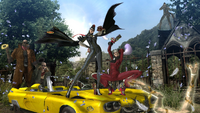
The type of witches you don't fuck with!
Shortly af Matt Leone of 1UP.com said of a pre-release version of the game's PS3 port at E3 2009: "The first thing I noticed was that, at the end of a normal combo, you can hold down the final button in the string to continuously fire gunshots—which looks incredibly cool when you kick someone and then keep your leg pointed at their face as your foot pours bullets on it." He added, "I'll be amazed if Bayonetta doesn't end up being one of the best action games this year." Staff at GameSpot UK were also generally impressed with the PS3 port, which they played on June 3. They called the "Witch Time" mechanic a "cool move" and one of the two boss battles they fought "pretty intense", and said "it's easy to see the similarities between the two over-the-top action games [Bayonetta and Devil May Cry]". They added, "Rampant violence and sexism is par for the course" in the game. 1UP.com staff also played a PS3 version for 15 minutes on the weekend of August 31 that year, at Platinum Games's "Feel Bayonetta" event in Tokyo's Roppongi district. They said that it "was very blurry" compared to an Xbox version displayed there, and that its frame rate "was all over the place. ... it was often hard to keep track of the action [in one scene] because of the graphical issues on PS3." Daniel Feit of Wired News played both versions at TGS 2009, and felt the Xbox version was "a little brighter and more colorful ... while the PS3 version cut scenes feel like you’re watching a movie through a sepia filter." He criticized the camera angles sometimes used in the game in both versions: "When Bayonetta runs too close to the edge of a scene, the camera can automatically focus on her and the wall instead of showing the enemies cornering her. Some of her larger hair-based attacks can also obscure the action." Still, he found the game's commands easy to learn and perform. In March 2009, Cam Shea of IGN Australia praised the developing game as "absolutely stunning-looking" and "a balls-out action game set amongst glorious European architecture" and has called its title character their "new favorite videogame character ever ... even cooler than [Devil May Cry's main character] Dante ... she has the playfulness and versatility of Dante, but wrapped up in some of the most visually inventive combat we've seen in a long while".
Similarly, GameSpy's Gerald Villoria praised the game in July that year as highly original to the point that it could end up like the poor-selling Ōkami (another Kamiya-directed game) for it—"[t]he premise, the characters, the action sequences, they're all entirely different from anything else I've ever seen," he wrote—and called its lead a "constantly moving", "remarkably multi-faceted" character "presented in an ultra-stylish way". Other reviewers compared her to former Alaskan governor Sarah Palin for her appearance and her glasses in particular. Kamiya has said of the comparisons, "in the US they say Sarah Palin. In Japan, they always bring up people like [singer-songwriter] Angela Aki. I think they say something similar in every country. That country's famous glasses girl. ... The thing with that impression is, you know, we've put out plenty of trailers now, and when you play the game and see the cutscenes, I think people will recognize Bayonetta as Bayonetta. Then people will look at Sarah Palin and say that she looks like Bayonetta."
Wii U version[]

Nintendo Treehouse Event - Bayonetta 1
In an interview with IGN, Hideki Kamiya stated that he would be interested in porting the game to the Wii U so that the console could have both the first and second entries of the series.[2]
In November 2013, Kamiya posted on Twitter that it would be possible to port the game to the system in time before the sequel is released[3], and remarked that it "would be a good idea to release (Bayonetta) 1 before 2", expessing hope that it comes to fruition.[4] Fans started a campaign named "Operation Dead Angels" afterwards, dedicated to persuading PlatinumGames and Nintendo into going through with the port.[5]
On June 10th, 2014, it was announced during Nintendo's Digital Event at E3 that the game was to be ported to the Wii U and packaged with Bayonetta 2. This release was published by Nintendo. Japanese and U.S. packages of Bayonetta 2 at retail included the game on disc, while both games were bundled in a physical "Special Edition" release in Europe. If either Bayonetta or Bayonetta 2 was purchased on the eShop before February 19, 2016, a discount would be applied on either of the games on the next purchase. Starting on February 19, 2016, to promote the release of Bayonetta as a paid downloadable character in Super Smash Bros. for Nintendo 3DS and Wii U, Bayonetta 2 was given a price drop on the eShop to $29.99 in the United States, the same price as a standalone physical release that released in stores that same day. Purchasing both games on the eShop no longed included a discount, as both games were now the same price.
The Wii U version of Bayonetta is a port of the original Xbox 360 release, and primarily runs at 60 frames-per-second. Unique to this version is exclusive Nintendo crossover content, with costumes based off popular Nintendo franchises such as Super Mario, The Legend of Zelda, and Metroid.
Bayonetta and Bayonetta 2 were both delisted from the Wii U Nintendo eShop in all regions on September 18, 2019.[6]
PC version[]
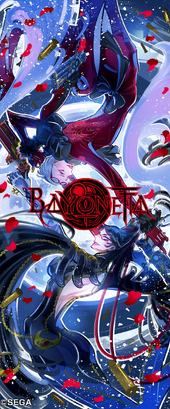
Artwork celebrating the Steam release of Bayonetta
Subsequent to a countdown[7] on Sega's official site, which started on April 1st, 2017 and has since finished, the game was officially released on Steam on April 11th, 2017.
According to early comments and reviews, the game is a "high-quality and well-crafted" port, which runs at a consistent frame rate and has numerous added graphical options, including the ability to turn off the HUD, anti-aliasing up to MSAA-16, anisotropic texture filtering, HDR lighting, and native support for 4K resolutions.
It appears to be a direct port of the Wii U version, however, the Nintendo-exclusive content has been removed. As Nintendo owns the rights to the Japanese voice tracks of the game, PlatinumGames was allowed to use it for this release.[8] All loading times within the port are instantaneous, subsequently, this means players cannot do any practicing between the Chapter, Alfheim or Gates of Hell loading screens unless the player quickly presses the "Back" button to go into Practice Mode.
PC Hardware Requirements
|
MINIMUM:
|
RECOMMENDED:
|
Nintendo Switch version[]
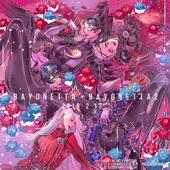
Artwork by Mari Shimazaki celebrating the Nintendo Switch releases of Bayonetta and Bayonetta 2
It was announced at The Game Awards 2017 on December 7th, 2017 that Bayonetta, along with Bayonetta 2, would receive ports to the Nintendo Switch. As with the Wii U version, this release was published by Nintendo. The Nintendo Switch version retains the Nintendo-exclusive costumes present in the Wii U version of the game.
The Nintendo Switch version maintains the 720p resolution of the Wii U release, however, it benefits from a more consistent framerate on both Handheld and TV modes. One can now start the game by pressing any of the face buttons on the title screen, instead of just the Plus button. The physical version of Bayonetta 2 contains a download code for the game in the United States and Europe. As on Wii U, if players chose to buy the games on the Nintendo eShop, buying one results in a discount on the other. Purchasing Bayonetta for $29.99 gives a $20 discount on Bayonetta 2, making the cost of that game $29.99. Purchasing Bayonetta 2 first for the standard $49.99 will give the purchaser a $20 discount on Bayonetta, making the cost of that game $9.99.
PlayStation 4 and Xbox One versions[]
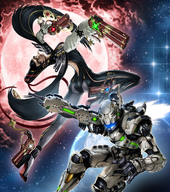
Artwork celebrating the PlayStation 4 and Xbox One releases of Bayonetta and Vanquish
After listings accidentally appeared on the Microsoft Store on December 5th, 2019[9], the Bayonetta & Vanquish 10th Anniversary Bundle was officially announced by Sega four days later on December 9th for Xbox One and PlayStation 4.[10] It was released on February 18th, 2020, and supports 4K resolution at 60 frames per second on Xbox One X and PS4 Pro. The physical "Launch Edition" comes with a special steelbook with new artwork for the two games.
The original Xbox 360 release of Bayonetta has been backwards compatible on Xbox One since September 9, 2016[11], already making the game playable on the system. It runs on the system's Xbox 360 emulator, so it is not considered a port of the game. There is no screen-tearing present when playing on any Xbox One system, and the frame rate has been significantly improved on Xbox One X, although the game still runs at 720p on all Xbox One systems.
Versions[]
See also[]
Reception[]
Bayonetta received "universal acclaim" on Metacritic and was tagged as a "Must-Play" game holding a metascore of 90/100 on both PC[12] and Xbox 360.[13] It also gave a metascore of 87/100 on PS3,[14] 81/100 on PS4,[15] 84/100 on Nintendo Switch,[16] and 86/100 on Wii U.[17]
References[]
- ↑ PlayStation 3 version developed by Nex Entertainment. Wii U and Nintendo Switch versions developed by Bee Tribe Digital Studio. Additional work for PC version done by Little Stone Software, and Armature Studio for the PlayStation 4 and Xbox One versions.
- ↑ http://www.ign.com/articles/2013/08/29/platinum-games-expresses-desire-for-wonderful-101-sequel
- ↑ https://twitter.com/PG_kamiya/status/403782878414127106
- ↑ https://twitter.com/PG_kamiya/status/403914531165835265
- ↑ http://www.neogaf.com/forum/showthread.php?t=720818
- ↑ https://www.usgamer.net/articles/bayonetta-1-and-2-will-leave-the-north-american-wii-u-eshop-next-week
- ↑ http://web.archive.org/web/20170401114857/http://www.sega.com/14111219
- ↑ https://twitter.com/PG_kamiya/status/963265303613382656
- ↑ https://www.engadget.com/2019/12/05/bayonetta-vanquish-4k-remasters-xbox-one-leak/
- ↑ https://www.youtube.com/watch?v=-5nE_xnAnqY
- ↑ https://www.eurogamer.net/articles/2016-09-09-bayonetta-joins-xbox-one-backwards-compatibility
- ↑ Metascore for Bayonetta on PCMetacritic, Retrieved March 24, 2020
- ↑ Metascore for Bayonetta on Xbox 360Metacritic, Retrieved March 24, 2020
- ↑ Metascore for Bayonetta on PS3Metacritic, Retrieved March 24, 2020
- ↑ Metascore for Bayonetta on PS4Metacritic, Retrieved March 24, 2020
- ↑ Metascore for Bayonetta on Nintendo SwitchMetacritic, Retrieved March 24, 2020
- ↑ Metascore for Bayonetta on Wii UMetacritic, Retrieved March 24, 2020
[]
| |||||||
| |||||||
| |||||||
|

